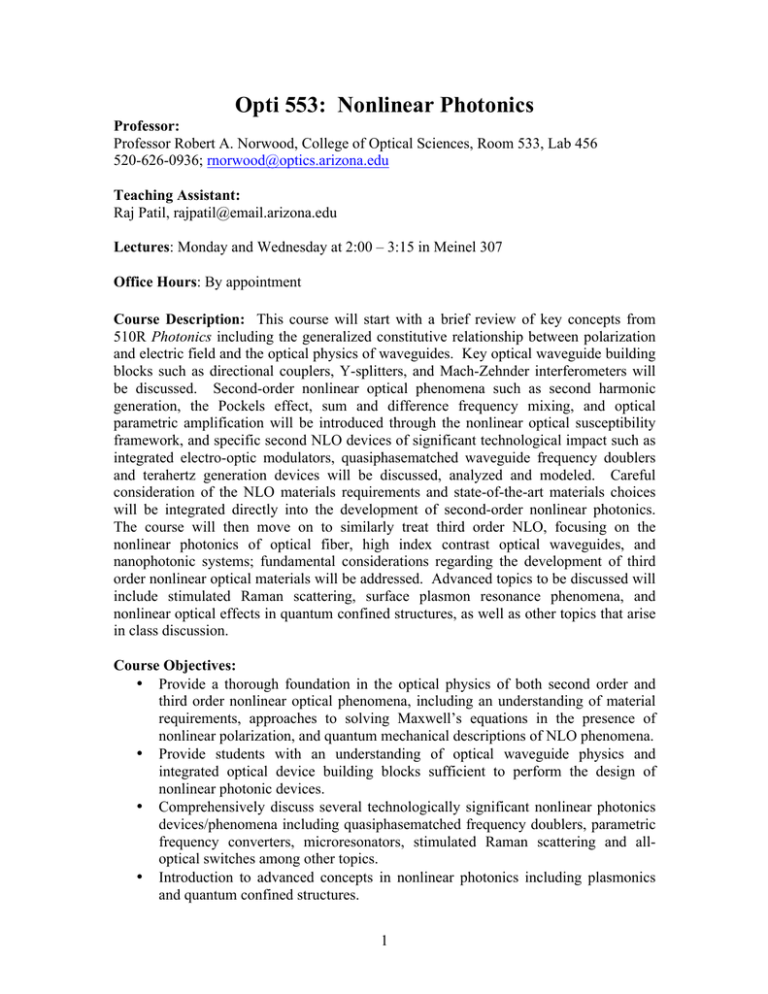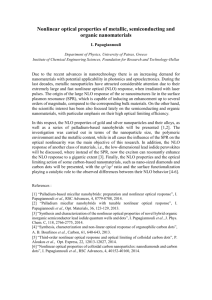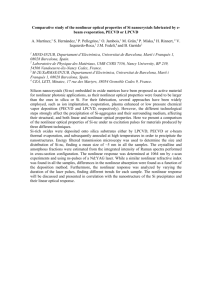Opti 553: Nonlinear Photonics
advertisement

Opti 553: Nonlinear Photonics Professor: Professor Robert A. Norwood, College of Optical Sciences, Room 533, Lab 456 520-626-0936; rnorwood@optics.arizona.edu Teaching Assistant: Raj Patil, rajpatil@email.arizona.edu Lectures: Monday and Wednesday at 2:00 – 3:15 in Meinel 307 Office Hours: By appointment Course Description: This course will start with a brief review of key concepts from 510R Photonics including the generalized constitutive relationship between polarization and electric field and the optical physics of waveguides. Key optical waveguide building blocks such as directional couplers, Y-splitters, and Mach-Zehnder interferometers will be discussed. Second-order nonlinear optical phenomena such as second harmonic generation, the Pockels effect, sum and difference frequency mixing, and optical parametric amplification will be introduced through the nonlinear optical susceptibility framework, and specific second NLO devices of significant technological impact such as integrated electro-optic modulators, quasiphasematched waveguide frequency doublers and terahertz generation devices will be discussed, analyzed and modeled. Careful consideration of the NLO materials requirements and state-of-the-art materials choices will be integrated directly into the development of second-order nonlinear photonics. The course will then move on to similarly treat third order NLO, focusing on the nonlinear photonics of optical fiber, high index contrast optical waveguides, and nanophotonic systems; fundamental considerations regarding the development of third order nonlinear optical materials will be addressed. Advanced topics to be discussed will include stimulated Raman scattering, surface plasmon resonance phenomena, and nonlinear optical effects in quantum confined structures, as well as other topics that arise in class discussion. Course Objectives: • Provide a thorough foundation in the optical physics of both second order and third order nonlinear optical phenomena, including an understanding of material requirements, approaches to solving Maxwell’s equations in the presence of nonlinear polarization, and quantum mechanical descriptions of NLO phenomena. • Provide students with an understanding of optical waveguide physics and integrated optical device building blocks sufficient to perform the design of nonlinear photonic devices. • Comprehensively discuss several technologically significant nonlinear photonics devices/phenomena including quasiphasematched frequency doublers, parametric frequency converters, microresonators, stimulated Raman scattering and alloptical switches among other topics. • Introduction to advanced concepts in nonlinear photonics including plasmonics and quantum confined structures. 1 Grading • Homework assignments - 40% • Midterm exam – 30% • Final exam – 30% The grade will be determined according to the cumulative percentage earned such that 90-100% = A, 80-89% = B, 70-79% = C, 60-69% = D, below 60% = E. Required Text Nonlinear Optics by Robert W. Boyd (Third Edition). This text is freely available online at www.sciencedirect.com. Additional readings and notes will be provided from a variety of sources. Course Outline 1. Brief Review of Electromagnetic Theory and Guided Waves a. Maxwell’s equations b. Fresnel relations c. Guided waves 2. Step-Index Thin-film Waveguides a. Dispersion relation b. Generalized parameters c. Fields of step-index waveguides d. Loss in thin-film waveguides 3. Three-Dimensional Waveguides a. Rectangular waveguide modes b. Marcatili method c. Effective index method 4. Optical Directional Couplers a. Coupled-mode description b. Δβ couplers 5. High Index Contrast Waveguides a. Materials candidates b. Microring resonators c. Slot waveguides 6. Nonlinear Optical Susceptibility a. Introduction to nonlinear optics (NLO) b. Formal definition of nonlinear susceptibility c. General properties d. Time domain description e. Macroscopic and microscopic quantities f. Units 7. Second Order NLO - χ (2) a. χ (2) wave equation b. χ (2) tensor and symmetry considerations c. Second harmonic generation (SHG) d. Phasematching and quasiphasematching (QPM) e. Sum frequency generation (SFG) 2 f. Difference frequency generation (DFG) and optical rectification g. Electro-optic (Pockels) effect (2) 8. χ Materials a. Perovskite crystals (lithium niobate, lithium tantalate, etc.) b. Other crystals (quartz, BBO, organic,….) c. Poled polymers (2) 9. χ Devices a. QPM waveguide frequency doublers b. Terahertz generation c. Integrated electro-optic devices 10. Third Order NLO - χ (3) a. χ (3) wave equation b. χ (3) tensor and symmetry considerations c. Origin of χ (3) d. Electronic χ (3) e. Orientational χ (3) f. Thermal χ (3) g. Band filling and population dependent χ (3) h. Intensity dependent refractive index – n2 11. χ (3) Effects a. Third harmonic generation (THG) b. Degenerate four-wave mixing (DFWM) c. Nondegenerate four-wave mixing (NDFWM) d. Self-focusing e. Self-phase modulation (SPM) f. Cross phase modulation (XPM) g. Optical Kerr effect (OKE) h. Stimulated Raman scattering (SRS) i. Stimulated Brillouin scattering (SBS) j. Nonlinear absorption (NLA) (3) 12. χ Materials a. Glasses b. Semiconductors c. Organic/Polymeric 13. Nonlinear Photonics in Single-mode Optical Fibers a. Review of LP modes b. Propagation of pulses in single-mode fibers c. Nonlinear envelope equation d. Self-phase modulation e. Stimulated Raman scattering f. Stimulated Brillouin scattering 14. Introduction to Advanced Topics a. Quantum confined structures b. Plasmonics c. Slow light and nonlinear photonics 3 Academic Integrity (http://web.arizona.edu/~studpubs/policies/cacaint.htm) According to the Arizona Code of Academic Integrity “Integrity is expected of every student in all academic work. The guiding principle of academic integrity is that a student’s submitted work must be the student’s own.” Unless otherwise noted by the instructor, work for all assignments in this course must be conducted independently by each student. Co-authored work of any kind is unacceptable. Misappropriation of exams before or after they are given will be considered academics misconduct. Misconduct of any kind will be prosecuted and may result in any or all of the following: • Reduction of grade • Failing grade • Referral to the Dean of Students for consideration of additional penalty, i.e. notation on a student’s transcript re. academic integrity violation, etc. Students with a Learning Disability If a student is registered with the Disability Resource Center, he/she must submit appropriate documentation to the instructor if he/she is requesting reasonable accommodations. (http://drc.arizona.edu/instructor/syllabus-statement.shtml). The information contained in this syllabus, other than the grade and absence policies, may be subject to change with reasonable advance notice, as deemed appropriate by the instructor. 4






